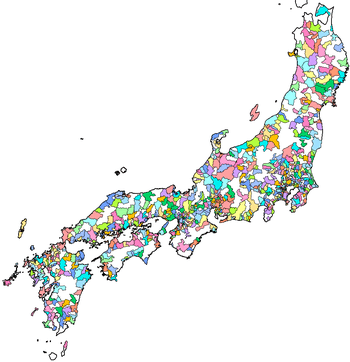Cities of Japan

| Administrative divisions of Japan |
|---|
| Prefectural |
| Prefectures |
| Sub-prefectural |
| Municipal |
| Sub-municipal |
A city (市 shi) is a local administrative unit in Japan. Cities are ranked on the same level as towns (町 machi) and villages (村 mura), with the difference that they are not a component of districts (郡 gun). Like other contemporary administrative units, they are defined by the Local Autonomy Law of 1947.
City status
Article 8 of the Local Autonomy Law sets the following conditions for a municipality to be designated as a city:
- Population must generally be 50,000 or greater (原則として人口5万人以上)
- At least 60% of households must be established in a central urban area (中心市街地の戸数が全戸数の6割以上)
- At least 60% of households must be employed in commerce, industry or other urban occupations (商工業等の都市的業態に従事する世帯人口が全人口の6割以上)
- Any other conditions set by prefectural ordinance must be satisfied (他に当該都道府県の条例で定める要件を満たしていること)
The designation is approved by the prefectural governor and the Minister for Internal Affairs.
A city can theoretically be demoted to a town or village when it fails to meet any of these conditions, but such a demotion has not happened to date. The least populous city, Utashinai, Hokkaido, has a population of six thousand, while a town in the same prefecture, Otofuke, Hokkaido, has nearly forty thousand.
Under the Act on Special Provisions concerning Merger of Municipalities (市町村の合併の特例等に関する法律, Act No. 59 of 2004), the standard of 50,000 inhabitants for the city status has been eased to 30,000 if such population is gained as a result of a merger of towns and/or villages, in order to facilitate such mergers to reduce administrative costs. Many municipalities gained city status under this eased standard. On the other hand, the municipalities recently gained the city status purely as a result of increase of population without expansion of area are limited to those listed in List of former towns or villages gained city status alone in Japan.
Classifications for large cities
The Cabinet of Japan can designate cities of at least 200,000 inhabitants to have the status of special city, core city, or designated city. These statuses expand the scope of administrative authority delegated from the prefectural government to the city government.
Status of Tokyo
Tokyo, Japan’s capital, existed as a city until 1943, but is now legally classified as a special type of prefecture called a metropolis (都 to). The 23 special wards of Tokyo, which constitute the core of the Tokyo metropolitan area, each have an administrative status analogous to that of cities. Tokyo also has several other incorporated cities, towns and villages within its jurisdiction.
See also
References
External links
- Directory of current Japanese city leaders and outline of system (2012)
- "Japan's Evolving Nested Municipal Hierarchy: The Race for Local Power in the 2000s," by A.J. Jacobs at Urban Studies Research, Vol. 2011 (2011); doi:10.1155/2011/692764
- "Large City System of Japan"; graphic shows Japanese city types at p. 1 [PDF 7 of 40]
